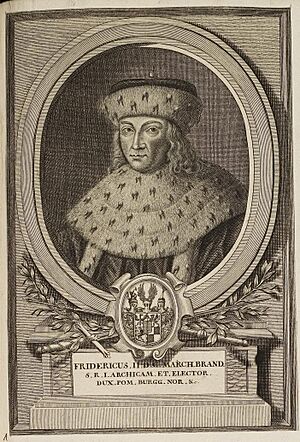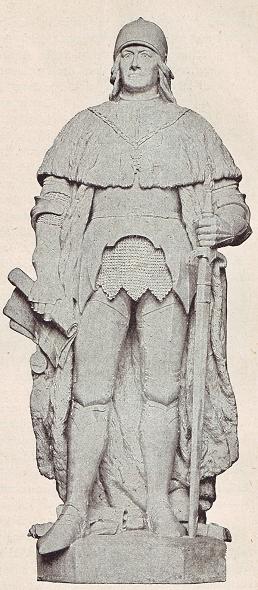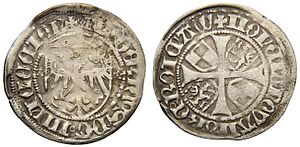Frederick II, Elector of Brandenburg facts for kids
Quick facts for kids Frederick II |
|
|---|---|

Posthumous engraving of Frederick II, 16th century
|
|
| Elector of Brandenburg | |
| Reign | 20 September 1440 – 10 February 1471 |
| Predecessor | Frederick I |
| Successor | Albert III Achilles |
| Born | 19 November 1413 Tangermünde castle, Margraviate of Brandenburg |
| Died | 10 February 1471 (aged 57) Neustadt an der Aisch, Bavaria |
| Spouse |
Catherine of Saxony
(m. 1441) |
| Issue | Dorothea of Brandenburg, Duchess of Saxe-Lauenburg Margaret of Brandenburg Johan of Brandenburg |
| House | Hohenzollern |
| Father | Frederick I, Elector of Brandenburg |
| Mother | Elisabeth of Bavaria |
Frederick II of Brandenburg (German: Friedrich II.), born on November 19, 1413, was an important ruler in German history. He was known by the nicknames "the Iron" (der Eiserne) and sometimes "Irontooth" (Eisenzahn). From 1440 until 1470, he served as a Prince-elector of the Margraviate of Brandenburg. He was a member of the powerful House of Hohenzollern, a family that ruled Brandenburg for many centuries. Frederick II passed away on February 10, 1471.
Contents
Biography of Frederick II
Frederick II was born at Tangermünde Castle, which was then part of the Margraviate of Brandenburg. His father was Frederick I, Elector of Brandenburg, the first ruler from the Hohenzollern family in Brandenburg. His mother was Elizabeth, who came from the Bavarian royal family.
Frederick was the second son in his family. His brothers included John and Albert Achilles. Both of them also became rulers of Brandenburg later on.
In 1421, when Frederick was just 8 years old, he was promised in marriage to Hedwig Jagiellon. However, she sadly passed away in 1431 before they could get married.
Becoming the Elector
In 1437, Frederick I, his father, decided to retire from ruling. He gave his oldest son, John, a different territory. Frederick II then took over the government of Brandenburg. Unlike his father, Frederick II decided to focus mainly on Brandenburg itself. He worked hard to bring peace among the nobles and the towns within his territory.
Building Berlin and Facing Challenges
Frederick II had big plans for the city of Berlin. In 1440, he wanted to build a new royal home on the Cölln island in the Spree River. This led to disagreements with the people of Berlin.
In 1448, the citizens of Berlin openly protested his plans. This event was called the Berliner Unwille, meaning "Berlin's Indignation." The citizens even flooded the area where the new palace was being built! However, Frederick II was determined. He managed to build his palace, known as the Stadtschloss, and also reduced some of the city's special rights.
Expanding Brandenburg's Territory
In 1454 and 1455, Frederick II made important agreements called the Treaties of Cölln and Mewe. Through these treaties, he successfully got back the region of Neumark (New March) from the Teutonic Order state. This was a significant achievement for Brandenburg.
Frederick II also faced a long struggle with the Duchy of Pomerania. Tired of these conflicts, he decided to step down from his role in 1470. He gave the rule of Brandenburg to his younger brother, Albert Achilles. Frederick II then moved to the Bayreuth Principality and passed away there a year later in Neustadt an der Aisch.
Frederick II's Family
On June 11, 1441, Frederick II married Catherine. She was a princess from Saxony. They had three children together:
- Dorothea of Brandenburg (born around 1446 – died March 1519). She married Duke John V of Saxe-Lauenburg in 1464.
- Margaret of Brandenburg (born around 1450 – died 1489). She married Bogislaw X, Duke of Pomerania.
- Johan of Brandenburg (born December 23, between 1406 and 1416 – died 1454).



